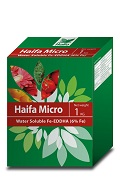Contact Us

Haifa Micro™
- Complements plant nutrition
- Facilitates growth and boosts vigor
- Correct deficiencies and cure mal-functioning of the plant
- Supports flowering and fruiting
- Enhances plant resistance to disease, insects and frost
Haifa Micro™ products
| Product |
Content |
pH stability range* |
|---|---|---|
| Haifa Micro™ Fe |
Iron-EDTA 13% |
acidic - neutral (1.5-6.5) |
| Haifa Micro™ Fe | Iron-EDDHA 6% | slightly acidic - alkaline (3-10) |
| Haifa Micro™ Mn |
Manganese-EDTA 13% |
slightly acidic - alkaline (3-10) |
| Haifa Micro™ Zn |
Zinc-EDTA 14% |
acidic - alkaline (2-10) |
| Haifa Micro™ Cu |
Copper-EDTA 14% |
acidic - alkaline (1.5-10) |
| Haifa Micro™ Combi |
7.1% Fe, 3.48% Mn, 1.02% Zn, 0.76% Cu, |
slightly acidic - neutral (3-6.5) |
| Haifa Micro™ soilless combination |
6.5% Fe-DTPA, 3.48 Mn-EDTA, |
slightly acidic - neutral (3.5-7.5) |
* Actual stability range depends on physical and chemical properties of the growth medium
The benefits of Haifa Micro™ - micronutrients fertilizer
- All micronutrients are in a chelated form, to maximize stability and efficiency
- Haifa Micro™ chelates are absorbed by the plant rapidly and efficiently
- Haifa Micro™ chelates are fully soluble in water
- Compatibility with a wide range of agrochemicals enables tank-mixing, thus reducing the cost of spray operations by minimizing the number of application needed
The mechanism of chelates
Chelate is a complex of a micronutrient ion and an organic molecule that "holds" it, called ligand. As long as the ion is attached to the ligand, it is protected from interacting with other ions in the solution, which might turn it unavailable for plant uptake.
As the micronutrient ions are consumed by the plant, more ions are released from the holding ligands, thus becoming available for plant uptake.
This mechanism maximizes the efficiency of the micro nutrients applied. When Haifa Micro™ is applied by Nutrigation™, the chelates ensure availability of micronutrients in both alkaline and acidic soils.

Iron (Fe) plays an important role in chlorophyll formation. It is involved in cell division that supports plant growth, and in other vital reactions in the plant.
Typical deficiency symptoms: leaf yellowing, interveinal chlorosis.
 Iron deficiencies in corn
Iron deficiencies in corn  Iron deficiencies in soybean
Iron deficiencies in soybean
 Iron deficiencies in canola
Iron deficiencies in canola
The solution: Haifa Micro™ Fe
Manganese (Mn) is required for photosynthesis and respiration. It improves green color and increases sugar and protein content. Manganese enhances plant tolerance to high light intensity.
Typical deficiency symptoms: chlorotic mosaic patterns on leaves.
 Manganese deficiencies in avocado
Manganese deficiencies in avocado  Manganese deficiencies in corn
Manganese deficiencies in corn
 Manganese deficiencies in soybean
Manganese deficiencies in soybean  Manganese deficiencies in tomato
Manganese deficiencies in tomato
The solution: Haifa Micro™ Mn
Zinc (Zn) is involved in synthesis of proteins and in the formation of seeds and promotes plant growth and vigor.
Typical deficiency symptoms: blotching of leaves.
 Zinc deficiencies in sugarcane
Zinc deficiencies in sugarcane  Zinc deficiencies in corn
Zinc deficiencies in corn
 Zinc deficiencies in pecan
Zinc deficiencies in pecan  Zinc deficiencies in citrus
Zinc deficiencies in citrus
The solution: Haifa Micro™ Zn
Copper (Cu) is essential for chlorophyll formation, cell wall building and many enzymatic mechanisms. It supports seed formation and reproduction, increases sugar content, intensifies color and improves flavor in fruits and vegetables.
Typical deficiency symptoms: wilting of top leaves.
 Copper deficiencies in wheat
Copper deficiencies in wheat  Copper deficiencies in corn
Copper deficiencies in corn
The solution: Haifa Micro™ Cu
Deficiency pictures - courtesy of IPNI (International Plant Nutrition Institute)







